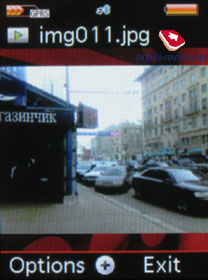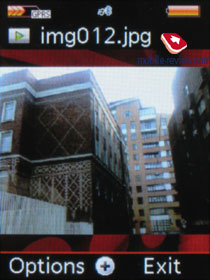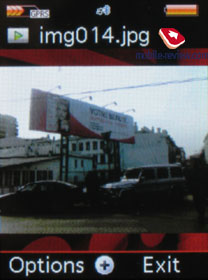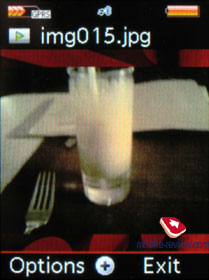|
|
Review of GSM-handset BenQ Siemens EL71
BenQ Siemens
EL71 live photos>>>
Standard kit:
- Handset
- Battery
- Charger
- User’s guide
- CD-ROM with synchronization software
To tell the truth, the most frequently asked question on forums
and in stores over the last few months was – “Is that a BenQ branded
mobile, or still a Siemens’s one?” Mess in product line, caused
by non-standard indexes of handsets confuses a lot of consumers.
At that, we can point out many situations, when that misunderstanding
resides even in minds of brand loyal consumers, and on the other
hand, people who aren’t positive in their knowledge of the mobile
phones market, are startled of BenQ Siemens label. Thus all these
issues bring certain hardships on the way of determining which handset
relates to which type. Further more, I have encountered commotion
among my colleagues on current positioning of BenQ Mobile’s devices.
In particular, someone may call model BenQ Siemens EL71 the new
flagship of the line-up, or at least a semi-flagship. As for me,
such thoughts are excessive, since the handset itself resides in
fashion class, which in its turn, is placed lower than BenQ Siemens
EF81, as it follows from the numeric index. In terms of functionality
the EL71 could claim the title of flagship by no means – it is rather
a solution for medium market.


No doubt Siemens Mobile is aware that the market is sensitive not
only to feature packed models, but also to products, appealing to
consumers’ senses of taste, in other words, original design always
wins laurels. And so happens that lack of technology to compete
as equals with Nokia, Sony Ericsson, has spurred up the company
to start creating solutions with distinguishable looks. That’s the
way a product line of 3 devices in metal casings (at least the most
part of their bodies is metallic) appeared on the market – this
series includes such devices as BenQ Siemens S68, BenQ Siemens EF81
and BenQ Siemens EL71. The main strength of those, according to
the marketing company’s slogan, is the used material; moreover one
of the company’s representatives had some words to say on this:
«these are the products, which will attract everybody’s attention
for sure, should you put them on a table in a cafe». And actually
the designers have put up a good show creating a couple of good-looking
handsets. Starting with May one should expect more commercials to
come, as all the three “metallic” phones, forming this trio will
have already been available on the markets. Like L’Amour Collection
by Nokia, those three many be considered as one singled out handsets
family. Though it was Motorola to pioneer usage of such positioning
type, even more, two out of three products in the line-up we are
writing about, are copies of Moto’s products (S68 reminds of L6/L7,
though simplified; EF81 is an upgraded version of V3x; and EL71
could have gotten a corresponding model if Motorola hadn’t cancelled
their handset). One more peculiarity of the strategy applied by
BenQ Mobile nowadays is imitation of successful competitor’s devices
positioning – and under conditions of the current market state this
proves to be useful, as sales are decreasing with every passing
day. For example, the S88 (BenQ’s product) is Sony Ericsson K750i
in a slightly different design, yet appeared with a year’s time
delay and the price, lowered by 15 Euros. Therefore considering
this enormous amount of clones, model BenQ Siemens EL71 can attract
much attention by its originality on no account, even though it
doesn’t have any direct rivals design wise.

All three models of the new line-up carry a new interface port
– Nano, at that in two cases out of three one is at liberty to install
a Lumberg-port, like on the previous devices. The truth of the matter
is that I can’t detect clear logic in this move, but the desire
of making money, as much as only possible, because by doing this
the company has forced its consumers to buy extra accessories. Just
come and think of this – those who actually dare buying these models
will have to pay up for new headsets, USB-cables and car kits. On
the whole this concept might look well-thought-out, yet with those
loyal to former Siemens brand consumers having doubts, this may
turn out to be a failure. So this is another argument against purchasing
models, residing in the new series. But let’s put all these joyless
thoughts aside.
Similar to the S68, model EL71 is based off Siemens S75, while
the EF81 relates to SXG75-like devices. An uncommon case, demonstrating,
that the S75 could have been armed with an up-to-date screen with
high resolution.
The design of EL71 is easy distinguishable against the background
of all the modern slides owing to two reasons: the former one is
the casing’s form, which is nearly rectangular with slightly curved
corners – the device is obviously different from the Korean sliders,
prevailing on the markets. And the latter sharp distinction is the
range of color schemes – apart from the black one, which actually
has been crowned the title of “the best color of the season” by
some manufacturers, the EL71 features Quartz Anthracite variation
of trim. We asked to send us exactly this one for our review deliberately,
as it seemed to be more attractive in the first place.
The device appears to be very portable (90x46.3x16.5 mm), though
one could hardly refer it to the slim class, however initially the
developers didn’t make it look like they were pretending to come
up with an extra-thin device. It will easily stick into both your
shirt’s pocket and jeans’ pocket. The weight of the handset is also
quite reasonable for products made of metal and equals to 94 grams.
Aluminum is applied to the framing, edging the display – it has
polished surface with imitated scratches, so one might be tricked
by the strong impression of this detail being made of metal. The
sides in their turn, are made of plastic, basically this material
is used in most parts of the casing – another metallic part is found
only on the rear, where the metallic battery cover is placed on.
Video,
handset’s design (7.65 Mb)>>>


The model’s display demonstrates great performance, claiming a
place among the best in its class nowadays and matching Motorola
V3x’s one (actually it was taken from the EF81). The screen uses
a QVGA resolution (240õ320 pixels, 31õ42 mm, 2 inches), and is capable
of displaying up to 262 K colors (TFT). Due to the re-worked interface
and main menu’s icons, the final impression of the hight quality,
embedded in this device gets even more intensive. Information on
the screen remains readable in the sun; the right angle makes all
the difference here. The fonts here are quite large. But still you
will be offered up to 8 text lines and 3 service lines (SMS input
mode, font size set to normal). Function of Zoom is also on-board
– using this you can either enlarge font size or make it smaller.
At any rate the difference seemingly comes to one line. The display
is handy and doesn’t have any outstanding specifications. As compared
to the EF81, amount of symbols in one line isn’t so big; it founds
on the fact the standard font size is slightly larger and the display
itself is inferior to the EF81‘s one (34õ45 mm, 2.2 inches) size
wise. But I suppose the majority of users will just pass this fact
by.
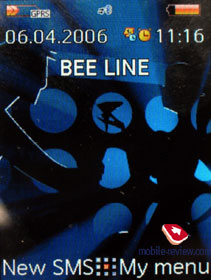

Following a tradition, the handset holds two loudspeakers (one
for conversations and the other one for playing back ring tones),
although their location has undergone significant changes. As you
might have already guessed, the main speakerphone is on the same
place is always and covered by a metallic grill, this loudspeaker
has an extra vent on the upper end.

As for the second loudspeaker, it is positioned more towards the
top of the slider and hidden by the metallic plate of the battery
cover. Reading the specifications the question of sound propagation
was of great interest to me; and to engineers’ credit I should say
that they have completely succeeded in this field. First of all
the objective doesn’t have a protecting glass – the only step the
developers have taken in order to prevent the camera from exposure
to wear and tear is placing the lens deeply in the casing. Consequently
this is the first vent for the sound can propagate in, the second
one is the hole on the upper rim – in fact they are hardly distinguishable.
If you take a closer look at the metallic plate, you will see a
hollow, which can’t be observed from the outside – and this is another
move aimed at keeping sound’s volume once it reaches the surface.
Video,
second loudspeaker (4.3 Mb)>>>
The loudspeaker’s volume is very high, yet it performs well even
on highest scales, but tends to utter crackling noises when move
the pointer to the very maximum. Though pay attention – this crackling
originates from the casing itself rather than the loudspeaker. Should
you remove the back cover, this noise disappears right there. Anyhow
the ring tones sound great – no matter where the handset lies, you
will definitely not miss a single call.

On the front panel to the right of the loudspeaker’s grill sits
a green service indicator – it triggers off on almost any event,
like missed calls and incoming messages. This prevents you from
switching backlighting on for a long time and the same time provides
necessary information on all events, that require your attention.
The assembling quality of the slider is high – the halves are firmly
fixed both when the handset is open and closed, don’t try to detect
any gap, as there aren’t any. The phone is armed with an auto-completion
mechanism, thus there is no way you will experience with sliding
it open or closing, at that you hear a distinctive sound (a mechanical
shock or the halves as there is no clicking system incorporated).
In contrast to Siemens SL75 the mechanism itself is tighter, but
still manages to remain very handy. Basically the system, used in
the SL75 has possessed one of the best auto-completion systems so
far. In this model the ways are made in the form of metallic rods
– a very familiar construction, known since the first products by
Samsung. Once again Siemens decided that presence of visible screws
makes a handset look charming; now you definitely know what kind
of “flight of fancy” you should expect on the rear. In my opinion
it’s not a key feature of the design, but rather a drawback, spoiling
the device’s outlook, as all these screws can be easily seen by
other people when you are receiving a call.
Video,
auto-completion mechanism (4.85 Mb)>>>


The left side panel holds a double key of volume control, while
the right side shows off the same type of button, though used for
calling up camera and fast dial of a single number taken from the
phonebook. I had an impression of this key being initially aimed
at voice dial, but seemingly at the very last moment it got repressed,
so the developers were ought to find a new function to bind up this
key with. Actually the idea is not bad at all, as we usually tend
to dial one and the same number over and over again (home, or your
girlfriend’s etc.), therefore it takes certain amount of time or
a numeric button, which is hidden when the device is in closed condition.
Though even this simple idea was spoiled by a minor flaw, though
it appears so only at the first glance – namely you need to confirm
the dial, so eventually you end up with the same two actions to
make. What was they reason for doing so I do not know – if I think
of possible explanations, preventing accident calls when the handset
lies in your pocket, or the key lock is not on, instantly spring
to my mind. Nonetheless all this doesn’t change the fact the usage
of fast dial button is not very handy.

The upper end features slot for pass a strap through; next to it
one will find a button, locking the back cover. Notable fact, that
the cover doesn’t have any gap either (well, almost no gap, plus
it will likely occur in course of usage). The interface port sits
on the right side, and as I mentioned above, it is a Nano port,
so not a single accessory from the earlier devices will do here.
You won’t experience any difficulties with managing the device
when it is closed – you will be still able to accept calls, read
messaged etc. The only cases when you need the slider to be open
are text inputting and number typing. In closed condition one can
dial a number only from the list of recent calls or the phonebook.
The phone may switch the key lock on automatically, so you won’t
press any button by pure accident. ProSlide function is also included
in the device – if someone isn’t aware of what this one does, it
plays back sounds or tunes on opening and closing of the device,
so you can choose any sound effect appealing to your hearing.
A weak point of the EL71’s design is the microphone’s location.
When examining the lower part of the device you will spot it staying
3.5 mm away from the bottom end. Many have already gotten used to
clasp mobile phone, not hold them with their fingers alone – if
you accidentally do grapple it, I will surprisingly find your interlocutor
not hearing what you say. From every quarter this seems to be a
critical issue, in fact I encountered these nuisances for countless
times over those three weeks I spent with the device. And on the
other hand when managing the device in closed condition, everything
works out perfectly, as your hand will hold the handset in the only
possible and right manner. So the only way to solve this problem
for users of the EL71 is being careful when getting a grip on the
open phone. As a matter of fact it’s an extremely rare case – I
can’t recall any other handsets suffering from the same flaw.

The function keys of the device pretend to be metallic, though
the material they are made of in the reality is plastic. The buttons
themselves are a bit smaller than one could have expected them to
be, however it is easily explained by the casing’s height, so I
would rate them as “providing medium comfort”. The backlighting
of these keys is white and actually faded. Four-way navigation keys
has OK key inserted into, which will not bring any new experience
either, another “so-so” detail. The handset possesses two special
music keys – start and pause, accompanied by a button bringing up
the directory with list of all music files (switches to the last
used tab, and this makes sense).

We could have expected the keypad to be metallic as that in the
EF81, which in its turn follows Motorola RAZR’s route. Fortunately
we won’t see that here – the manufacturer decided to implement a
rubberized keypad. In many respects it is similar to a metallic
block with keys of minimal height and a bit handier. As for the
drawbacks, this solution doesn’t blend with the overall outlook
of the device, and would better fit in cheaper handsets. At the
same time the buttons have fair click sensation, so typing gives
mostly positive emotions, providing that you adapt to a smaller
keypad. The keys are lit with a blue backlighting system, which
is readily distinguishable in various types of environment.



A part of the rear side is occupied by a 1.3 Mpix camera’s lens,
flash and a small mirror. The built-in light diode may be of some
use as a flashlight, if you really want to give this idea a try,
press and hold the camera button, turning the thing off is done
in the same manner.

The handset provides 17.5 Mb of memory available for users, as
you see the size of manageable storage directly depends on amount
of installed applications, to cut the long story short, this leaves
you with about 16 Mb. The phone also has a slot for microSD (TransFlash)
memory cards, though hot swap trick won’t work here – to change
memory card you will have to take out the battery. The slot is allocated
near the SIM-card’s bed.

The battery applied to this model is Li-Ion with the capacity of
600 mAh and reminds of a small chocolate bar to some extent. Considering
the fact the platform this device is built on is similar to Siemens
S75, where the battery has the characteristic of 820 mAh, we did
not cherish hopes for outstanding life time, as apart from different
index the reviewed handset has a better display and loudspeaker
incorporated. The manufacturers claims 300 hours of life time in
standby and up to 5 hours of talk time. Though in practice, the
charge lasted for approximately 15 hours with 45 minutes of conversations
and 20 minutes of other functions usage. In other words the phone
requires charging every evening. It can be good for about 2 days
with 45 minutes of talk time alone. Anyway, in Europe our results
are more likely to be extended by 20-205 percents owing to higher
density of base stations and better coverage. In Germany, for example,
two days of stable operation will look quite normal if you spent
about 30 minutes on conversations a day. Yet the average life time
is rather poor and significantly differs for the worse from all
the products introduced on the market. That’s a factor you should
keep in mind while considering this phone as your future mobile
device. Full recharge time of the battery is almost 2 hours


Menu
The device represents the same family as Siemens S75 and Siemens
S68, but differs in the way several functions work and distinct
software kit. The interface has also been re-worked for the better;
to be precise the icons look way better, what adds some more points
to the handset. The main menu has an appearance of a 3x4 grid with
fast number navigation function provided. By tradition you are at
liberty to make up a My Menu of your own. Besides a standard variety
of functions, numeric keys may be assigned to a certain telephone
number, so here you will have to choose one of two options, whether
to tie it up with a function or with a contact. In some functions
and menus tabs system rules the roost, which can be switched between
by horizontal declinations of the navigation key. As distinct from
other models, the right side has a key for fast dial of a single
number, which can be set in a corresponding menu.
Video,
handset menu (8.16 Mb)>>>
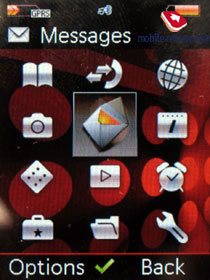
Software wise this model doesn’t duplicate Siemens S75 – there
are tons of differences of primary importance.
Phonebook. The device’s phonebook is capable of
storing up to 1000 entries, yet in settings you will be offered
the value of 500 contacts, thus it indicates that they actually
widened the functionality, but could not integrate a proper counter.
For each contact you can submit four telephone numbers, two fax
numbers, for e-mail addresses, two page URLs, company’s name, etc.
At that the phone numbers are displayed in a separate window, while
fax numbers are located in private and business tabs. At the beginning
of the general list the phone shows entries on English language,
and after these – all contacts with the title names on all other
languages. Each contact may be tied to a nickname, though in this
case its place in the list will depend on the language, the main
name of the contact was written on – so an English nickname may
end up in the part containing only Russian entries.
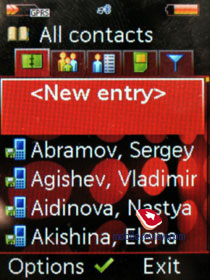
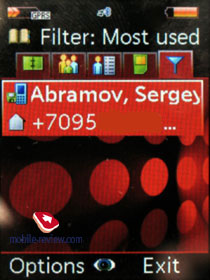
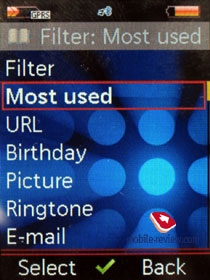
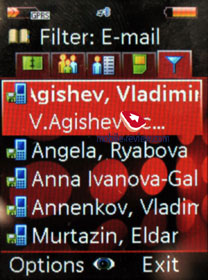
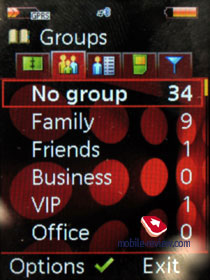
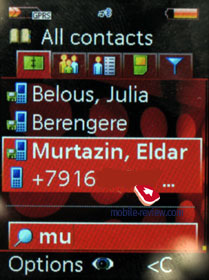
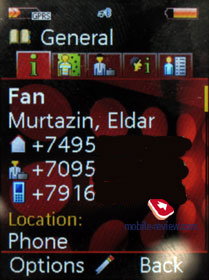
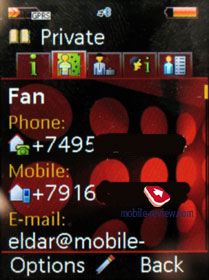
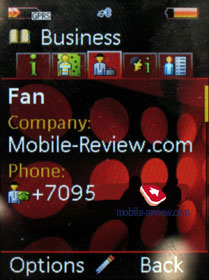
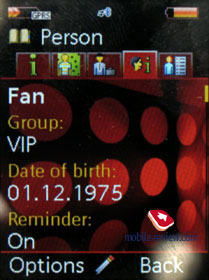
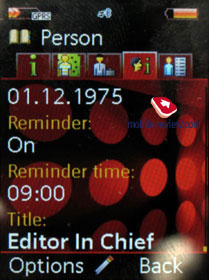
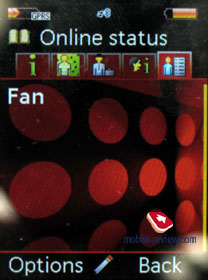
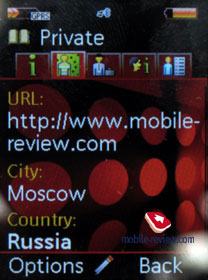
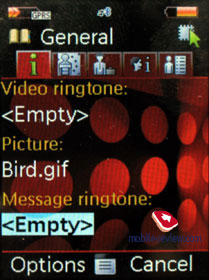
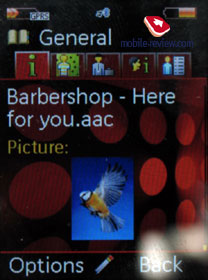
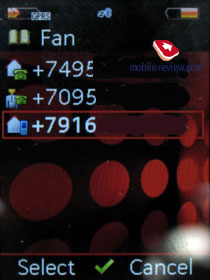
Among personal settings for each contact, one can set a particular
ring tone, image, group, and birthday date. Each contact may be
tied up with a video clip, which will be played back on an incoming
call. Entries, stored on SIM-card may be browsed in a special menu
item. By default user is able to operate with 10 groups, one of
which bears the name of “Not in a group”, this means all groupless
contacts find their place here. No new groups can be created; each
existing one can be bound up with a ring tone and a personal image.
All contacts may be sorted by e-mail, page URL, birthday or by
mailing list, even more, all sorted entries are displayed in a separate
window. No filters for various groups of contacts are available.
The last used filter is always applied on every start up. It seems
voice dial was striked off the short list of functions and as a
result it isn’t featured in the phone.
In phonebook’s settings you can select general list’s sorting type
(by first name or last name), assign fields which will be displayed
behind each tab etc. On the whole the capabilities of this applications
are very wide and give a lot of pleasing moments even to the most
demanding consumer.
Call record. Up to 100 entries are stored in the
memory of each call type – incoming, outgoing and missed. All calls
are shown in common list too, with special icons for easier understanding.
For each record you can see detailed information (date and time).
Traditionally here you can find settings for call costs and time
limitations; this requires entering PIN-code
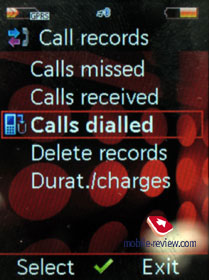
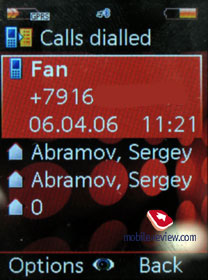

Internet. The phone has WEB-browser which supports
HTML protocol. In case with English pages it’s almost okay, meanwhile
Russian encoding causes significant problems, and it is becoming
a “good” trend for the company. Files and applications uploading
can’t be switched to background mode – you just won’t be able to
minimize the corresponding window, as it is realized on handsets
by Motorola, Sony Ericsson. Of pleasing things I am to make a note
of automatic addresses saving – when you start typing an URL, the
device will offer you a list of the last visited pages. If you are
not completely satisfied with the capacity provided by the default
browser, I strongly recommend installing Opera Mini – one of the
best clients out there.
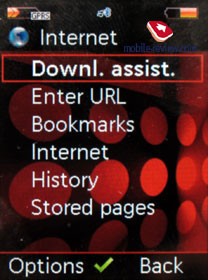
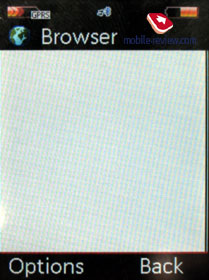
Messaging. Three types of messages can be created
– SMS, MMS and E-mail. When you are creating SMS messages, you can
type long compositions since joined message system is supported,
maximal length is 755 symbols of latin font and up to 330 for cyrilics.
Extended modes are not supported; you can only insert text template
or contact from the phone book. T9 dictionary without word auto
match function is supported. The words that are not present in the
database can be saved afterwards. Next time they will be used, and
basically they get easily recognized. Traditionally, this phone
supports text line the letters for the button you are pressing,
however another tradition was kept as well, and Russian letters
do not match the common layout for most phones.
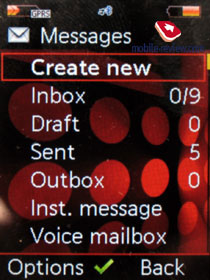
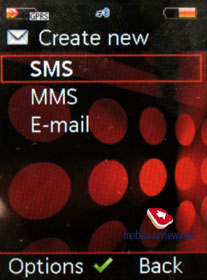
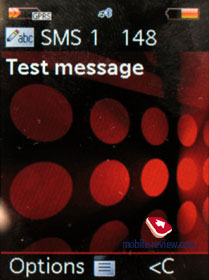
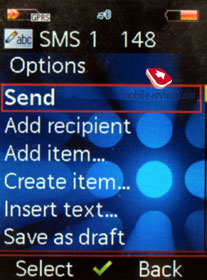

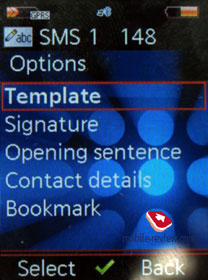

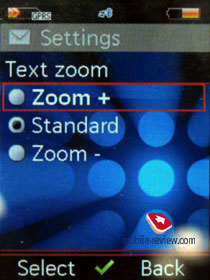
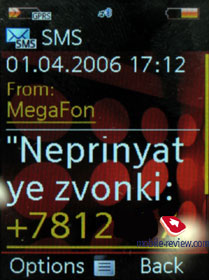
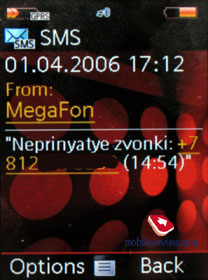
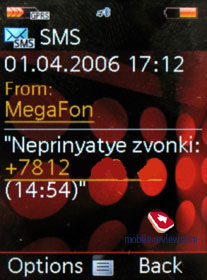
While creating a new SMS user can insert various text templates,
entries from the phonebook, organizer, and also music files or video
clips. Depending on the added content, a message may transform into
a MMS.
A photo, text, video, sound and contact can be inserted into MMS
message; this means that all basic functions are present. Photo
and video recording can be done directly from MMS editing menu.
Maximal size for MMS message is 195kb. Besides you can limit MMS
by 95kb (a lot of network operators are limiting the size by 100kb),
another separate option – maximal size allowed by network operator.

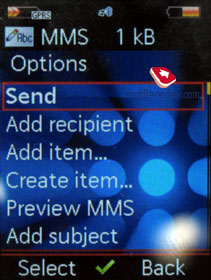
A profile must be created before composing email; otherwise this
section will not open. The email client supports SMTP, POP3, IMAP4
protocols. Any file (even those that are not supported by the phone)
can be used as attachments. Maximal attachment size should not exceed
10mb. Russian encodings are not supported correctly. Handset’s memory
is used for storing e-mail letters, at that you’ll have only around
1 Mb of space, without possibility of turning to memory card, so
this function isn’t of much use.
There aren’t any preset templates, you should create them yourself.
These templates can be used as headings or signature for your message.
Settings for voice mail can be found in the same menu.
Organizer consists of calendar, voice memos, world
time settings and synchronization point.
The Calendar is displayed in monthly view by default – all dates
which have assigned tasks are shaded. Having selected one of those
dates, you will see how the bottom of the screen gets filled up
with appointments, which can be instantly browsed. The other view
type is weekly one, featuring hourly timetable – one can set start
time for any day, choose which days are working ones and which are
not. Considering the pleasing fact that all birthdays are automatically
directed to the Calendar, the developers provided a function for
turning off their appearance on the general list.
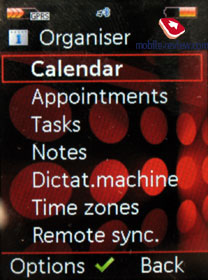

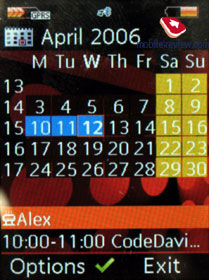
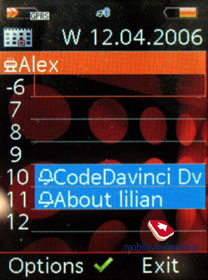
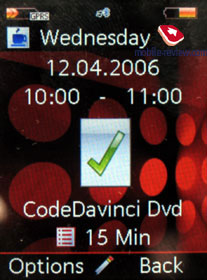
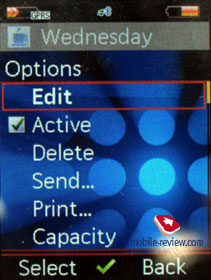
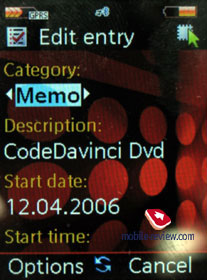
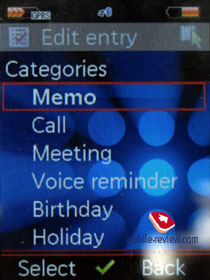
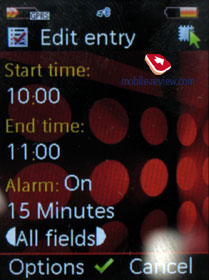
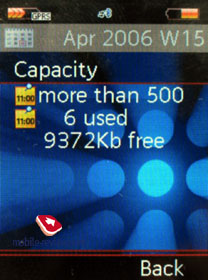
Each event in the Calendar is tied up with a theme, stand and end
dates, alarm triggering time (if needed). Next thing you can adjust
is reoccurrence (daily, weekly, monthly, yearly, never). Number
of entries is limited only to the size of available storage (organizer
is capable of using nearly 9 Mb, though in practice we figured out
it can accept more than 500 events). Apart text notes you can create
events with voice messages.
Dictaphone, placed in this menu item, is re-named to “Voice reminder”
– total length of recording is 100 hours. The function also operates
in course of a telephone conversation, in this case you will need
to call it up through the main menu – regrettably there is no special
fast access key for it (even if you assign one of the side keys,
it just won’t start up). Calls recordings are labeled similarly
to all other files – namely you won’t see contact’s number or name
if you have him on your contact list. While the dictaphone is working,
usage of all other functions is restricted – you can neither use
the keypad nor do any other actions, so should your interlocutor
hang up, the voice recorder won’t turn off, therefore you will be
forced to do this manually.

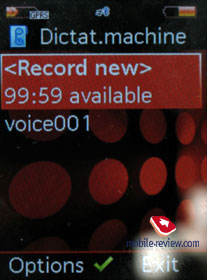
To-do list almost completely copies entries in the Calendar – the
only single difference lies in competition status (done or not)
and priority level (5 scales, starting from the highest one and
ending with the minor level). End date and alarm clock are easily
set via corresponding options. The to-do list doesn’t have Reoccurrence
option.
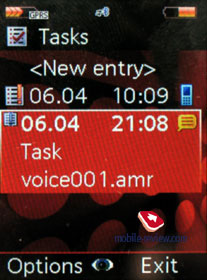
Notes – simple text notes, entered by user. You can create a special
folder with private notes, which can be accessed only in case you
know the password.
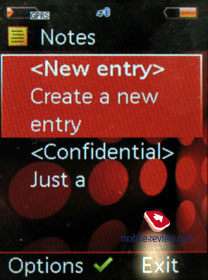
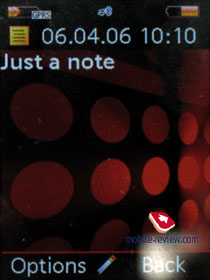
The World time function seems to remain the same from one handsets
generation to another. You can check out difference in time between
two selected cities.
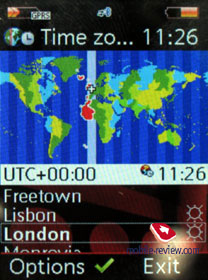
«Synchronization» provides possibility of setting up corresponding
profiles, selecting applications, choosing type of data transfer.
The developers have also incorporated capability for using external
servers for storing contacts and calendar events (SyncML protocol).
Synchronization with a remote site is carried out without any nuisances.
Alarm clock. The handset has only one alarm clock
on-boards, which can be set to certain days of week, playing various
tunes and enabled to use Autosnooze. Not a single extra feature
can be found here.
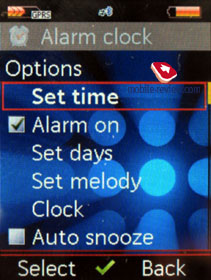
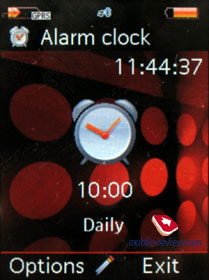
Games. Number of pre-installed games may vary
depending on given region – e.g. the Russian users will find a new
game installed in the phone – NY City, a simulator of night life
in a big city, which can be even endowed with the label of quest.
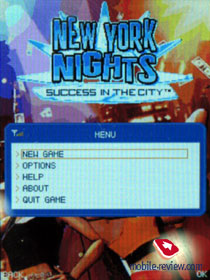
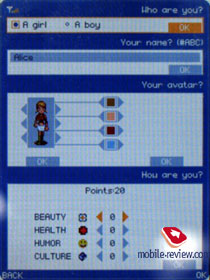

Media player. The general concept of the player
is similar to 75-series – to be precise, the media player embedded
in the EL71 features four tabs, the first one displays all music
files (when uploading new tracks, you better refresh the entire
list, as the phone looks for music everywhere), the other tab holds
playlists, the third bookmark shows all images, while the last one
plays back video clips. The device supports the following formats:
MP3, AAC, MIDI, AAC, AAC+, AAC++, AMR-NB, PCM(WAV), SP-MIDI, XMF.
As for formats which videos can be stored in – the handset offers
both 3GP and mpeg4 with the possibility of setting playback to full-screen
mode.
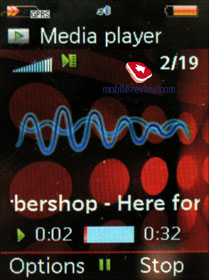
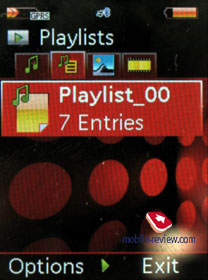

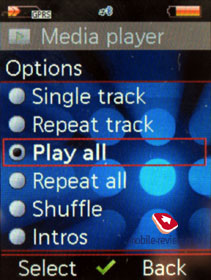
On an incoming call, the media player automatically pauses and
once you finish conversation, it continues playback from exactly
the same point where it was interrupted. Some pros of the new edition:
from this point on the phone is armed with Shuffle function, unseen
in the previous devices. Though the developers decided to follow
a tradition and excluded equalizers from the media player. Playlists
are still capable of holding up to 25 tracks, moreover you can select
an entire folder on a memory card on no account – on the contrary
you will have to deal with selection of tracks one by one. Nonetheless
the player may be minimized, however neither track’s title nor remaining
time are not displayed on the home screen. Without any doubts we
can declare that they are actually working on media player’s improvement,
nevertheless the work advances too slowly. In our firmware version,
the media player seemed pretty bug packed – for some reason incoming
call’s number didn’t pop up on the display sometimes, even though
the application wasn’t minimized. I do hope the manufacturer will
do its best to eliminate this drawback by the time the phone appears
in retail stores. If I needed to add a few concluding words, I would
say the functionality of the given media player is rather poor as
compared to products by some other manufacturers – it’s just a set
of basic functions with no extras.
Extras. Here a few items found their home – the
first of which is “My applications”, where pre-installed utility,
namely Download Manager and Photo Editor reside in. «Photo Editor»
offers a powerful mobile graphic editing toolkit, although I bet
only fans will call up this app on regular basis, since it takes
loads of time to get used to and work with. And should you need
to modify a picture, you better use your home PC.

Calculator. It has extended abilities, like exponent calculation,
square root and reciprocal. One of the options is simple unit converter,
however there is another way to launch it, separate option.
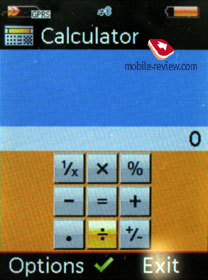
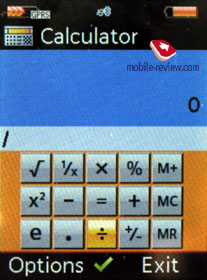
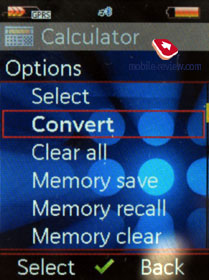
Sound recorder – the very same and already described Dictaphone.
Stopwatch. Allows measuring time periods with intermediate
results (up to 100).

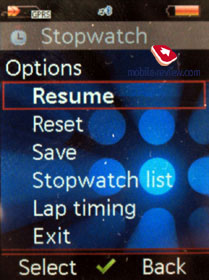
Countdown time is extended owing to provided sub-settings
for cooking eggs, rice, potato etc.
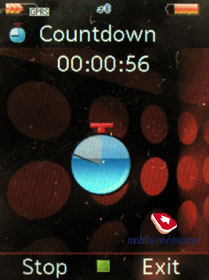
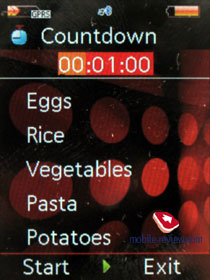
Unit coverter – allows converting one units
into others.

The Calculator allows estimating time span,
separating two entered dates, at that data type may be changes (years,
months, weeks, days). Naturally, this function won’t find much of
use in dayily routine, but may come in handy in come cases.
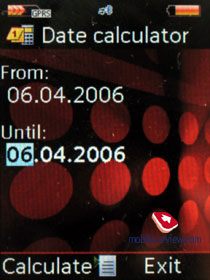
My stuff Traditional File Manager
from Siemens. Besides simple folders with graphics, video and themes/sounds,
folder with games and applications is displayed here as well. As
always, file system is easily managed – you are at liberty to move
around both folders and files, copy information taken from them
back and forth. Memory card owns its own specialized tab. The application
conducts search by name, type and creation date.
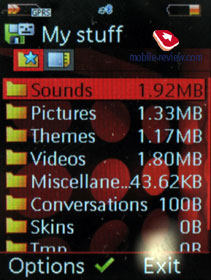
Settings. Behind this tab you will
find profiles with flexible options – e.g. you can select tunes
for every single event, starting with incoming calls and messaged
and finishing with organizer and other functions. Vibration alarm
has various modes, which are also completely adjustable.
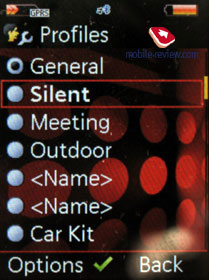
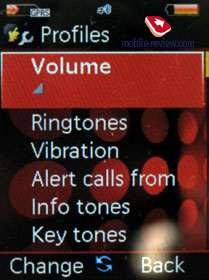

The handset possesses the function of turning off
on the schedule. But what is more interesting, when pressing power
button while at standby screen, the device offers you either to
just switch it off or cancel all alerts and scheduled tasks along
with turning off, or simply deactivate all sound alarms without
shutting off the device.
The same menu houses EDGE and Bluetooth settings.
Camera. The handset is equipped with
a 1.3 Mpix camera, which is not a satisfactory judging by the current
competition level, but this manufacturer has always been well disposed
towards incorporating low-resolution camera modules into fashion
handsets. The module itself is produced by Samsung, similar to those,
Siemens S75 are armed with (the camera is slightly better than that
made by OmniVision in the first place).
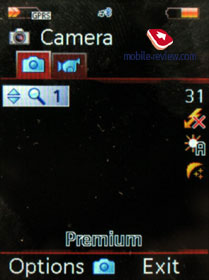
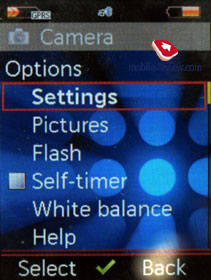

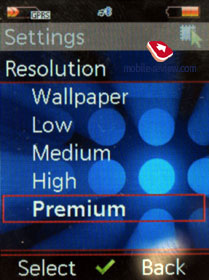

The maximum resolution of a shot is 1280õ1024 pixels
at 250-330 Kb per one image. The truth should be told – on the handset’s
display all pictures look fine, yet on PC they are of moderate quality,
as usual though. The camera is capable of applying 5x digital zoom
– when reaching the last scale on the zoom bar, shot’s size decreases
to 110-150 Kb with image sharpness going down as well. At maximum
resolution you are able to use these special effects: Sepia, gradations
of grey, green, orange and purple. As you are decreasing zoom value,
the effects pool is extended with Emboss. All taken photos may be
saved both in handset’s memory and memory card. White balance has
three options to choose from – auto, outdoor and indoor. Night mode
and flash setup are also on place. Talking of image resolution,
again you will need to guess about them, as the developers have
applied labels, that don’t bear much of semantic load – premium
(1280õ1024), high (640õ480), medium (320õ240), low (160õ120), wallpaper
(132õ176). Pictures, which are aimed at applying to contacts in
the phonebook later on are saved in the lowest quality. Resolution
may be inspected only via file’s attributes.
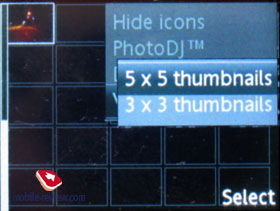
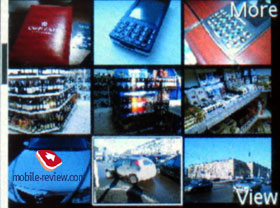
The EL71 lacks multishot mode, as well as capacity
of shooting fast moving objects, since the device cannot provide
the required shutter and processing speed.
BenQ Siemens EL71
|
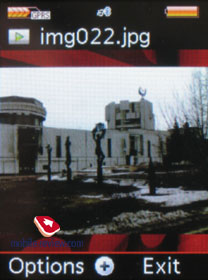 |
 |
(+)
óâåëè÷èòü, 1280x1024, JPEG |
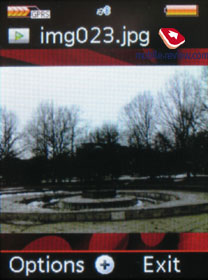 |
 |
(+)
óâåëè÷èòü, 1280x1024, JPEG |
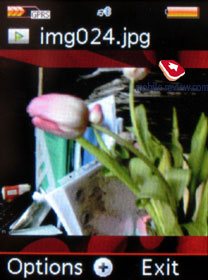 |
 |
(+)
óâåëè÷èòü, 1280x1024, JPEG |
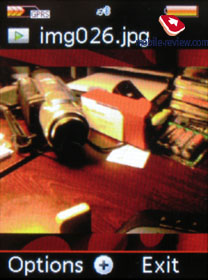 |
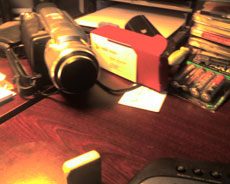 |
(+)
óâåëè÷èòü, 1280x1024, JPEG |
 |
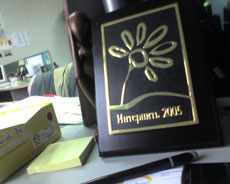 |
(+)
óâåëè÷èòü, 1280x1024, JPEG |
 |
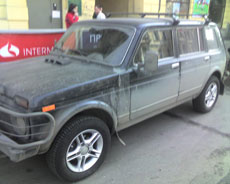 |
(+)
óâåëè÷èòü, 1280x1024, JPEG |
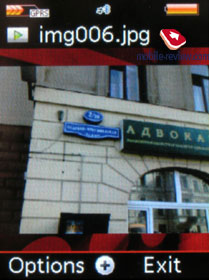 |
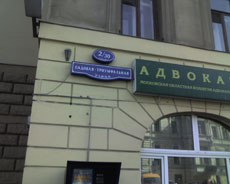 |
(+)
óâåëè÷èòü, 1280x1024, JPEG |
Video recording. Length of a video clip directly depends
on available storage back in handset’s memory or on memory cards;
still it can’t exceed the value of 1 hour 30 minutes. With regard
to extras, there one will discover setting for recording clips aimed
at attaching short or long MMS messages. Size wise these two types
differ a lot – the short one takes up 93 Kb and the long recording
occupies 293 Kb. While already recording a video, you may either
turn the sound off or on. White balance is adjusted without any
efforts on your part, yet you can handle this parameter yourself.
Similar to single shot mode, you need to guess about resolution
judging by inexpressive titles - premium stands for 176x144 pixels,
129x96 pixels resolution is marked as normal. While shooting video,
you can apply digital zoom and brightness control. Any stored video
clip may be switched to full screen mode – the handset easily recognizes
and plays back files, recorded with the help of any external device.
The built-in flash serves as a flashlight as well (we mentioned
this in the very beginning of the review)
Sample
video 1 (384 Kb)>>>
Sample
video 2 (285 Kb)>>>
Sample
video 3 (151 Kb)>>>
Sample
video 4 (252 Kb)>>>
Performance. The handset bases off
Siemens S75 core, but due to increased resolution and the CPU, which
has been handed down from the predecessor, it doesn’t come up with
extreme performance, and demonstrates worse results in course of
the tests. On the whole, the performance yields to other devices
representing the new generation, manufactured by other companies.
Model name EL71
Jbenchmark 1 1.1.1
Version
Total Score: 1704
Details:
Text 642
2D Shapes 480
3D Shapes 172
Fill Rate 69
Animation 341
Screen Width 240
Screen Height 320
Color Screen true
Number of Colors 65536 |
Model name S75
Jbenchmark 1 1.1.1
Version
Total Score: 2595
Details:
Text 755
2D Shapes 630
3D Shapes 409
Fill Rate 236
Animation 565
Screen Width 132
Screen Height 176
Color Screen true
Number of Colors 65536 |
Jbenchmark 2
Version 2.1.1
Total Score: 101
Details:
Image Manipulation 79
Text 136
Sprites 165
3D Transform 87
User Interface 68
Screen (canvas) Width 240
Screen (canvas) Height 264
Color Screen true
Number of Colors 65536 |
Jbenchmark 2
Version 2.1.1
Total Score: 176
Details:
Image Manipulation 149
Text 235
Sprites 333
3D Transform 157
User Interface 91
Screen (canvas) Width 132
Screen (canvas) Height 154
Color Screen true
Number of Colors 65536 |
Perfomance
Jbenchmark3D HQ: 64
Jbenchmark3D LQ: 83
Triangles ps: 9814
kTexes ps: 729
version: 3.1.0
Screen(canvas)width: 240
Screen(canvas)height: 320 |
Perfomance
Jbenchmark3D HQ: 109
Jbenchmark3D LQ: 144
Triangles ps: 18891
kTexes ps: 833
version: 3.1.0
Screen(canvas)width: 132
Screen(canvas)height: 176 |
Impressions
The reception quality of the device is beyond question,
ring tones are heard in almost any environment, while 64 tone polyphony
steps aside at the sight of mass MP3 tunes usage. Crackling noises
of the loudspeaker are hardly distinguishable in outdoor space,
though in indoors areas they appear only in case of badly selected
tunes. Pre-set ring tones are of some interest – the device wins
some points owing to their splendid sounding (examples may be found
in our video clips. Vibration alarm’s strength is above average
– on flat surfaces the device is more likely to start moving around.
Various profiles allow adjusting the alarm to your own tastes –
on the whole this function is materialized very well.

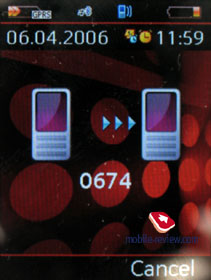
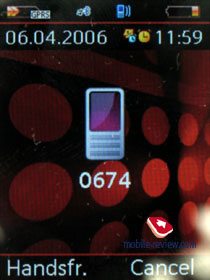

As to questions, which we failed to find a comprehensive
answer on, we haven’t managed to figure out SVG format support –
even though it is mentioned on the official specifications list,
in fact the device lacks support of this file extension. To all
appearances, they simply couldn’t catch up with the release date
and integrate Flash Lite, I suppose this application will show up
later on.
Reviewing the major drawbacks of BenQ handsets, to
be more precise those left from Siemens old models, we need to stress
Java-applications processing, and unavailability of working with
them in background mode. Absence of this possibility leaves JIMM
out of the game, or such common thing with other mobile phones,
when you minimize application on an incoming call and then just
continue working with it after hanging up. There is no way you can
download Java-applications from other phones – WAP takes over this
task. This limitation may become critical for a share of people,
seeking for fully functional product, with the capability of extending
its potential even further; and as regards the other group of consumers,
it won’t make all the difference. It’s important to remember that
similarly to the S75, the Java-engine has been renewed in almost
every way, consequently you won’t find support of MIDP 1.0 on the
handset, and in light of this fact you will be unable to install
many applications and games.
Speed wise, the device is inferior to many other handsets,
representing the same class –its affected mainly by the increased
resolution and out-of-date platform. Calling up this or that menu
item or function may take up to one second, or even more – this
delay is easily detectable. However the handset performs speedy
in majority of menus, there are obvious drawbacks when talking about
loading time. Unfortunately for all improvements, like better screen
we have to pay sometimes considerably high price.
As to accessories available for this model, one will
likely cast a glance at a music cable IMH-100, which makes it possible
to connect your handset to a Hi-Fi system. And the EL71 is not the
only product supporting this gadget - BenQ Siemens C81 features
the same capability. Personally I don’t see any great meaning or
purpose in this cable, nevertheless I cannot deny the fact there
are people fond of listening to music taken from their mobile on
home stereo system – really, how can one prefer a mobile device,
even if it provides amazing sound quality and purity (talking about
handsets in general) to a good stereo? And yes, seizing the opportunity,
I would like to make my opinion public: using iPod in place of a
stereo system in a car is the same kind of perversion!
But let’s get back to the point where I ended my review
of the EL71’s characteristics. As a matter of fact the handset is
an updated version of Siemens S75, materialized in a different form
factor with great outlook and materials’ quality. But should we
even touch upon the software kit, the phone may be given up for
lost – the amount of bugs and flaw in the default firmware is enormous.
Those, who didn’t believe in defectiveness of Siemens S75/SL75 in
their time, should really call at forums and find out more on them,
in particular endless complaints of users concerning stability of
the phones. All the hopes of staunch defenders, who continue spreading
the same nonsense “all drawbacks will be fixed really soon just
wait for the next firmware version and you will see it for yourself!”,
are still unrealizable dreams.
So if you need a phone you for making calls and you
don’t have on mind thoughts about synchronizing it with PC, using
as an MP3 player or bringing up the camera too often, and at the
same time desire of a cool-looking handset, BenQ Siemens EL71 should
be in top three on your short list. For 450 USD you will get a device
with pick/hang up buttons and something more. The handset will become
available in April. Judging by the statistics of pre-orders, the
distributors expect moderate demand, which means the price will
soon go down to 350-400 USD. This level is more likely to be reached
by this summer and considering the fact the company is almost on
the wane, the price of 300 USD and less in the end of August doesn’t
look an impossible way of scenario development. And from that moment
on the model may hit the highest positions of priority ranks, in
case the developers will fix all the flaws of firmware.
P.S. I wonder when all these talentless programmers
will be fired and new enthusiastic ones will take their place? I
mean those who are capable of making up stable solutions, based
on the current platform? Taking into consideration leading positions
in the field of design, general concept and realization quality,
all devices of BenQ Siemens are seemingly promising.
Review of BenQ Siemens
EF81
Eldar Murtazin (eldar@mobile-review.com)
Translated by Oleg Kononosov (oleg.kononosov@mobile-review.com)
Published — 13 April 2006
Have something to add?! Write us... eldar@mobile-review.com
|
News:
[ 31-07 16:21 ]Sir Jony Ive: Apple Isn't In It For The Money
[ 31-07 13:34 ]Video: Nokia Designer Interviews
[ 31-07 13:10 ]RIM To Layoff 3,000 More Employees
[ 30-07 20:59 ]Video: iPhone 5 Housing Shown Off
[ 30-07 19:12 ]Android Fortunes Decline In U.S.
[ 25-07 16:18 ]Why Apple Is Suing Samsung?
[ 25-07 15:53 ]A Few Choice Quotes About Apple ... By Samsung
[ 23-07 20:25 ]Russian iOS Hacker Calls It A Day
[ 23-07 17:40 ]Video: It's Still Not Out, But Galaxy Note 10.1 Gets An Ad
[ 19-07 19:10 ]Another Loss For Nokia: $1 Billion Down In Q2
[ 19-07 17:22 ]British Judge Orders Apple To Run Ads Saying Samsung Did Not Copy Them
[ 19-07 16:57 ]iPhone 5 To Feature Nano-SIM Cards
[ 18-07 14:20 ]What The iPad Could Have Looked Like ...
[ 18-07 13:25 ]App Store Hack Is Still Going Strong Despite Apple's Best Efforts
[ 13-07 12:34 ]Infographic: The (Hypothetical) Sale Of RIM
[ 13-07 11:10 ]Video: iPhone Hacker Makes In-App Purchases Free
[ 12-07 19:50 ]iPhone 5 Images Leak Again
[ 12-07 17:51 ]Android Takes 50%+ Of U.S. And Europe
[ 11-07 16:02 ]Apple Involved In 60% Of Patent Suits
[ 11-07 13:14 ]Video: Kindle Fire Gets A Jelly Bean
Subscribe
|




















































































































